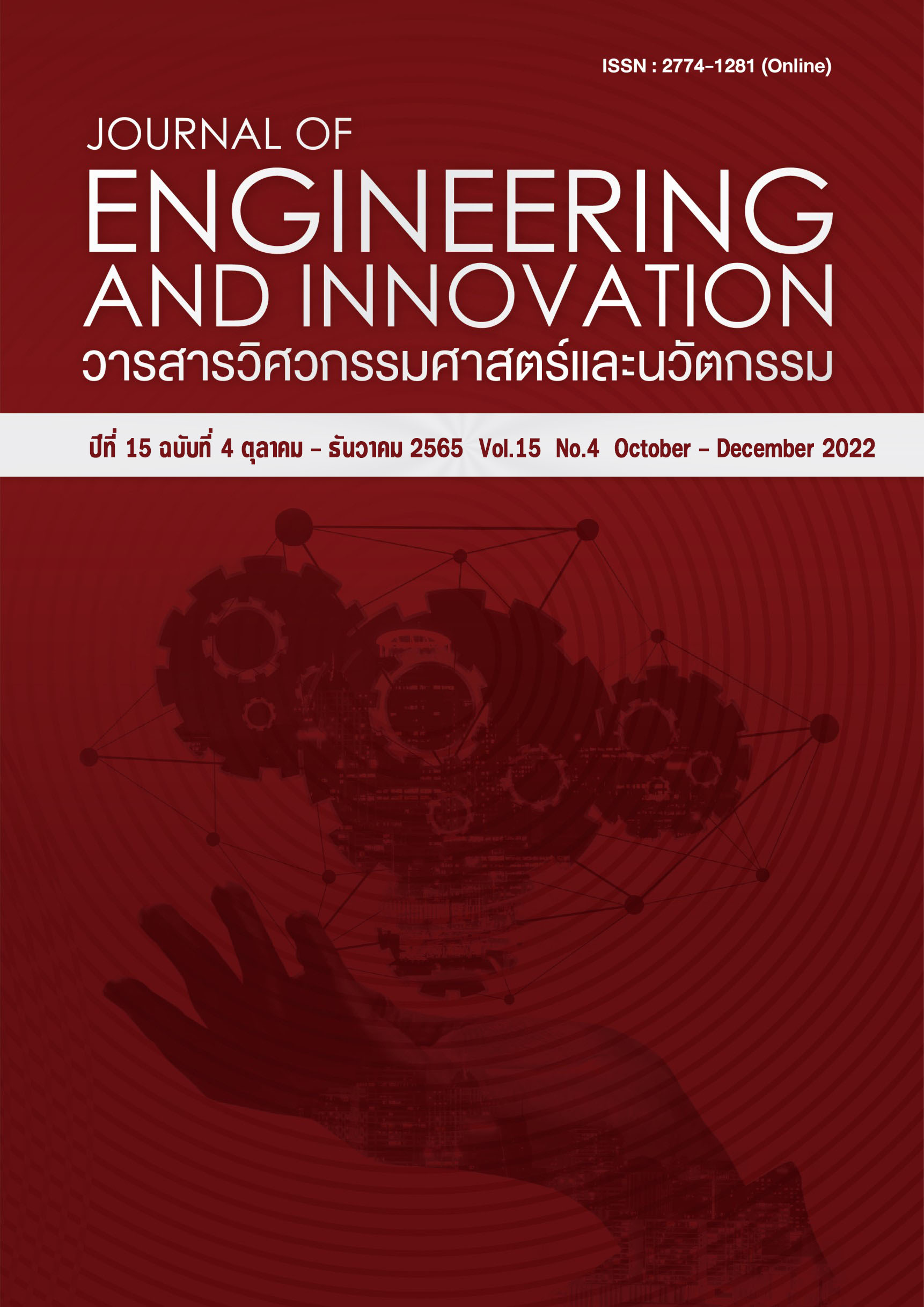การตรวจสอบผลกระทบของระยะเวลานำต่อค่าบูลวิปเอฟเฟคในโซ่อุปทานแบบ การสั่งซื้อสินค้าจากสองแหล่ง สำหรับตัวแบบออเทอรีเกรสซีฟอันดับที่หนึ่ง
Main Article Content
บทคัดย่อ
ปัจจุบันนี้ งานวิจัยที่ศึกษาเกี่ยวกับปรากฏการณ์บูลวิปเอฟเฟคภายใต้การสั่งซื้อสินค้าจากสองแหล่งนั้นมีจำนวนไม่มาก รวมถึงไม่ได้กล่าวอย่างชัดเจนว่า ระยะเวลานำมีผลกระทบต่อค่าบูลวิปเอฟเฟคหรือไม่และอย่างไรภายใต้การสั่งซื้อสินค้าจากสองแหล่ง ดังนั้นงานวิจัยฉบับนี้จะตรวจสอบผลกระทบของระยะเวลานำต่อค่าบูลวิปเอฟเฟคในโซ่อุปทานแบบการสั่งซื้อสินค้าจากสองแหล่ง โดยที่คำสั่งซื้อของผู้ค้าปลีกจะถูกแบ่งไปยังผู้ผลิตสินค้าทั้ง 2 แห่ง ระยะเวลานำระหว่างช่วงของผู้ผลิตสินค้าทั้งสองและผู้ค้าปลีกทั้งแบบเท่ากันและไม่เท่ากันจะถูกตรวจสอบ งานวิจัยฉบับนี้จะใช้วิธีการจำลองสถานการณ์โดยสร้างความต้องการของลูกค้าตามตัวแบบออเทอรีเกรสซีฟอันดับที่หนึ่ง (The First Order Autoregressive, AR(1)) ทุกสมาชิกในโซ่อุปทานใช้นโยบายการจัดการสินค้าคงคลังเป็นแบบสั่งซื้อที่เหมาะสม (Order-up-to Inventory Policy) และใช้เทคนิคการพยากรณ์แบบถัวเฉลี่ยเคลื่อนที่ ผลการวิจัยชี้ให้เห็นว่าการเพิ่มขึ้นของระยะเวลานำไม่จำเป็นที่ค่าบูลวิปเอฟเฟคต้องเพิ่มขึ้นด้วย
Article Details
เอกสารอ้างอิง
Chopra, S., and Meindl, P., 2001. Supply Chain Management: Strategy, Planning, and Operation, Prentice Hall, United States.
Simchi-Levi, D., Kaminsky, P., and Simchi-Levi, E., 2008. Designing and Managing the Supply Chain: Concepts, Strategies and Case Studies, Third Edition. McGraw-Hill.
Lee, H., Padmanabhan, V., and Whang, S., 1997a. Information distortion in a supply chain: the bullwhip effect, Management Science, 43(4), pp. 546-558
Lee, H., Padmanabhan, V., and Whang, S., 1997b. The bullwhip effect in supply chains, Sloan Management Review, 38(3), pp. 93-102.
Forrester, J.W., 1958. Industrial dynamics, A major breakthrough for decision makers, Harvard Business Review, 36(4), pp. 67–96.
Sterman, J.D., 1989. Modeling managerial behavior: Misperceptions of feedback in a dynamic decision making experiment, Management Science, 35(3), pp. 321-339.
Chen, F., Drezner, Z., Ryan, J.K., and Simchi-Levi, D., 2000a. Quantifying the bullwhip effect in a simple supply chain: The impact of forecasting, lead time, and information, Management Science, 46(3), pp. 436-443.
Chen, F., Ryan, J.K., and Simchi-Levi, D., 2000b. The impact of exponential smoothing forecasts on the bullwhip effect, Naval Research Logistics, 47(4), pp. 269-286.
Luong, H.T., 2007. Measure of bullwhip effect in supply chain with autoregressive demand process, European Journal of Operational Research, 180(3), pp. 1086-1097
Liu, H., and Wang, P., 2007. Bullwhip effect analysis in supply chain for demand forecasting technology, Systems Engineering - Theory&Practice, 27(7), pp. 26-33.
Agrawal, S., Sengupta, R.N., and Shanker, K., 2009. Impact of information sharing and lead time on bullwhip effect and on-hand inventory, European Journal of Operational Research, 192(2), pp.576–593.
Pati, R.K., Vrat, P., and Kumar, P., 2010. Quantifying bullwhip effect in a closed loop supply chain, OPSEARCH, 47(4), pp. 231–253.
Cho, D.W., and Lee, Y.H., 2011. Bullwhip effect measure in a seasonal supply chain, Journal of Intelligent Manufacturing (forthcoming); available online at http://www.springer.com
Pereira, J., Takahashi, K., Ahumada, L., and Paredes, F., 2009. Flexibility dimensions to control the bullwhip effect in a supply chain, International Journal of Production Research, 47(22), pp. 6357–6374.
Nepal, B., Murat, A., and Chinnam, R.B., 2012. The bullwhip effect in capacitated supply chains with consideration for product life-cycle aspects, International Journal of Production Economics, 136(2), pp. 318–331.
Bayraktar, E., Koh, S.C.L., Gunasekaranc, A., Sari, K., and Tatoglue, E., 2008. The role of forecasting on bullwhip effect for E-SCM applications, International Journal of Production Economics, 113(1), pp. 193-204.
Wright, D., and Yuan, X., 2008. Mitigating the bullwhip effect by ordering policies and forecasting methods, International Journal of Production Economics, 113(2), pp. 587-597.
Coppini, M., Rossignoli, C., Rossi, T., and Strozzi, F., 2010. Bullwhip effect and inventory oscillations analysis using the beer game model, International Journal of Production Research, 48(13), pp. 3943-3956.
Ciancimino, E., Cannella, S., Bruccoleri, M., and Framinan, J.M., 2012. On the bullwhip avoidance phase: The synchronised supply chain, European Journal of Operational Research, 221(1), pp. 49–63.
Wang, J., Kuo, J., Chou, S., and Wang, S., 2010. A comparison of bullwhip effect in a single-stage supply chain for autocorrelated demands when using correct, MA, and EWMA methods. Expert Systems with Applications, 37(7), pp. 4726-4736.
Sirikasemsuk, K., and Luong, H.T., 2017. Measure of bullwhip effect in supply chains with first-order bivariate vector autoregression time-series demand model. Computers & Operations Research, 78, pp.59-79.
Sirikasemsuk, K., Luong, H.T., 2014. Measure of bullwhip effect – a dual sourcing model. International Journal of Operational Research, 20(4), pp.396–426.
Duc, T.T.H., Luong, H.T., and Kim, Y., 2010. Effect of the third-party warehouse on bullwhip effect and inventory cost in supply chains, International Journal of Production Economics, 124(2), pp. 395-407.
Xu, K., Dong, Y., and Evers, P.T., 2001. Towards better coordination of the supply chain, Transportation Research Part E: Logistics and Transportation Review, 37(1), pp. 35–54.
Raghunathan, S., 2003. Impact of demand correlation on the value of and incentives for information sharing in a supply chain, European Journal of Operational Research, 146(3), pp. 634–649.
Kim, J.G., Chatfield, D., Harrison, T.P., and Hayya, J.C., 2006. Quantifying the bullwhip effect in a supply chain with stochastic lead time, European Journal of Operational Research, 173(2), pp. 617–636.
Duc, T.T.H., Luong, H.T., and Kim, Y., 2008. A measure of the bullwhip effect in supply chains with stochastic lead time, The International Journal of Advanced Manufacturing Technology, 38(11-12), pp. 1201-1212.
Tunacan, T., and Torkul, O., 2021. The impact of information sharing on different performance indicators in a multi-level supply chain. Tehnički vjesnik, 28(6), pp. 1960-1974.
Ernawati, D., Pudji, E., Rahmawati, N., and Alfin, M., 2021. Bullwhip effect reduction using vendor managed inventory (VMI) method in supply chain of manufacturing company. In Journal of Physics: Conference Series (Vol. 1899, No. 1, p. 012082). IOP Publishing.
Hariastuti, N. L. P., Fardiya, E., and Dwicahyani, A. R., 2020. Supply chain analysis using distribution requirement planning (DRP) based on bullwhip effect parameter (case study: Ud. Narwastu, Surabaya). Jurnal IPTEK, 24(2), pp. 95-104.
Sjurahudin, H., and Vikaliana, R., 2022. Implementation of collaborative, planning, forecasting and replenishment (CPFR) to reduce the bullwhip effect in MSME Sate Madura Cak Kholil. Ilomata International Journal of Management, 3(1), pp. 446-456.
กิตติวัฒน์ สิริเกษมสุข, จารุวรรณ แก้วล้วน, และ จุฑามาศ เกษแก้ว, "การศึกษาพฤติกรรมของบลูวิปเอฟเฟคภายใต้การสั่งซื้อสินค้าจากสองแหล่งในโซ่อุปทาน โดยใช้เทคนิคการพยากรณ์แบบถัวเฉลี่ยเคลื่อนที่ (A study of the bullwhip effect phenomenon under a dual–supplier system by using the moving average forecasting

